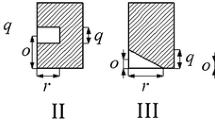Abstract
A stochastic model of the dynamic behavior of sawn timber beams of Argentinean Eucalyptus grandis is herein presented. The aim of this work was to study the influence of the timber knots in the dynamical response of timber beams. The presence of knots is known to be the main source of the lengthwise variability and reduction in bending strength and stiffness in timber beams. The following parameters of the timber knots are considered stochastic: position along the beam span and within the beam cross section, shape and dimensions. Experimental data, obtained from bending and density tests, are employed to find the timber modulus of elasticity and density. On the other hand, the characteristics of the timber knots used in the stochastic model were obtained from a visual survey performed with 25 beams of the same species. The problem of the natural vibration frequencies of the timber beam is approximated with the finite element method. Numerical results are obtained using Monte Carlo simulations (MCS). The uncertainties of the timber knot parameters and their influence are quantified with the probability density function of the frequencies. Statistical results obtained by means of MCS are compared with experimental measurements in order to assess the accuracy of the stochastic model. The present approach that gives a more realistic description of timber structures correlates better with experiments.















Similar content being viewed by others
References
Ang AHS, Tang WH (2007) Probability concepts in engineering: emphasis on applications to civil and environmental engineering. Wiley, London
Baño V, Arriaga F, Soilán A, Guaita M (2011) Prediction of bending load capacity of timber beams using a finite element method simulation of knots and grain deviation. Biosyst Eng 109(4):241–249
Baño V, Arguelles-Bustillo R, Regueira R, Guaita M (2012) Determinación de la curva tensión-deformación en madera de Pinus sylvestris L. para la simulación numérica de vigas de madera libre de defectos. Mater constr 62(306):269–284
Baño V, Arriaga F, Guaita M (2013) Determination of the influence of size and position of knots on load capacity and stress distribution in timber beams of Pinus sylvestris using finite element model. Biosyst Eng 114(3):214–222
Bathe KJ (1996) Finite element procedures, vol 1. Pentice hall, Englewood Cliffs
Czmoch I (1998) Influence of structural timber variability on reliability and damage tolerance of timber beams. Ph. D. thesis, Luleå tekniska universitet
Escalante MR, Rougier VC, Sampaio R, Rosales MB (2012) Buckling of wood columns with uncertain properties, mecánica computacional. Uncertain Stoch Model XXXI(14):2735–2744
Faber MH, Khler J, Sorensen JD (2004) Probabilistic modeling of graded timber material properties. Struct Saf 26(3):295–309
Guindos P, Guatia M (2013) A three-dimensional wood material model to simulate the behavior of wood with any type of knot at the macro-scale. Wood Sci Technol 47(3):585–599
Guindos P, Guatia M (2014) The analytical influence of all types of knots on bending. Wood Sci Technol 48(3):533–552
IRAM:9662-2 (2006) Madera laminada encolada estructural. Clasificación visual de las tablas por resistencia. Parte 1: Tablas de \(Eucalyptus\). Instituto Argentino de Racionalización de Materiales IRAM, Buenos Aires
Isaksson T (1999) Modeling the variability of bending strength in structural timber: length and load configuration effects. División of the Structural Engineering, Lund University, Lund
Köhler J (2007) Reliability of timber structures. Vdf Hochschulverlag AG, 301
Köhler J, Sørensen JD, Faber MH et al (2007) Probabilistic modeling of timber structures. Struct saf 29(4):255–267
Piter J (2003) Clasificación por resistencia de la madera aserrada como material estructural. Desarrollo de un método para el \(Eucalyptus\) de Argentina. Ph.D. thesis, Universidad Nacional de la Plata
Rubinstein RY (1981) Simulation and the Monte Carlo method. Wiley, London
Shannon C (1948) A mathematical theory of communication. Bell Tech J 27:379–423
UNE-EN 408 (1995) Estructuras de madera. Madera aserrada y madera laminada encolada para uso estructural. Determinación de algunas propiedades físicas y mecánicas. Estructuras de Madera, AENOR - Asociación Espaola de Normalización y Certificación, Madrid
Acknowledgments
The authors acknowledge the financial support of CONICET, SGCyT-UNS, MINCyT from Argentina, and CNPq and FAPERJ from Brazil. The authors also acknowledge Dr. J.C. Piter for the data employed in this work.
Author information
Authors and Affiliations
Corresponding author
Additional information
Technical Editor: Marcelo A. Trindade.
Rights and permissions
About this article
Cite this article
García, D.A., Sampaio, R. & Rosales, M.B. Vibrational problems of timber beams with knots considering uncertainties. J Braz. Soc. Mech. Sci. Eng. 38, 2661–2673 (2016). https://doi.org/10.1007/s40430-015-0418-1
Received:
Accepted:
Published:
Issue Date:
DOI: https://doi.org/10.1007/s40430-015-0418-1




